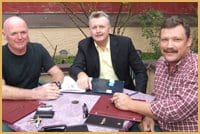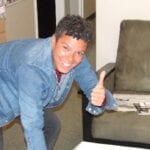“Disappointed. That’s really all I can say.”
That’s how Vancouver Pride Society (VPS) president John Boychuk described his reaction to the scant turnout at a Sep 6 Pride forum that saw board members heavily outnumber community participants.
Apart from Boychuk, parade director Ken Coolen, secretary Rod Zelles and sponsorship coordinator Caryl Dolinko, only three people —The Centre’s new executive director Michael Harding, Gayvan.com’s Angus Praught and a member of the Bob Loblaw comedy troupe —showed up.
In a newsletter dated Aug 19, the VPS notes there has been “a lot of talk about Pride this season and a lot of opinions about where we’re going, how we are working and what the future for Pride is.
“We’ll address your concerns, questions and queries about Pride, from our corporate sponsorship and parade float entries to costs of events and community involvement,” the newsletter promises. “This is the place to be heard and allow us to address the misconceptions, the information and the facts about Pride,” it concludes, inviting community members to attend the forum at Jupiter Café.
“This is such a vocal community when nothing is going right, but when something is going right, we don’t talk about it,” Boychuk tells Xtra West half an hour into the meeting, as he scans the nearly empty patio.
Despite the meagre attendance, there was some discussion of changes to the parade route, the level of corporate presence in the parade, and trying to balance Pride’s grassroots history with the desire to see it garner even more publicity and a higher profile.
Asked about the potential changes to the parade route, Boychuk says it’s the city pushing the VPS to change.
“We’re not looking. The city has told us: ‘You’re going to move, whether you like it or not, whether your community likes it or not. We have to discuss this because this is a growing problem. The streets where you currently have your parade were not designed for parades.'”
Boychuk says the city, citing safety issues due to the growing number of spectators, suggested the VPS consider adopting the Santa Claus parade route on Georgia and Howe Sts.
“You gotta do something because there’s no way this city can continue to operate and we know you guys are gonna get bigger and bigger and bigger, so therefore we need to be on top of this,” Boychuk says the city told him.
When Xtra West contacted the city’s special events coordinator Muriel Honey for reaction to the VPS president’s claim, she said she had no comment except to say that Boychuk “has been part of the discussion about moving it. I will have no comment until I talk to Mr Boychuk.”
Last issue Honey told Xtra West that the current parade route is “a very confined space” for so many spectators.
“We want everybody to be able to enjoy it, and enjoy it safely, and that would mean extending it somehow,” Honey said. “Whether that’s a total change of route, or a partial change of route, or an extension of the route or what, we don’t know.”
The city is open to “whatever [the VPS] might want to suggest,” she added.
Boychuk reiterates that the VPS has no plans to take the parade out of the West End, emphasizing he wants to avoid a repeat of the community uproar two years ago when the VPS last suggested a parade route change.
“Let’s look at our history. Let’s look at what the community really does want and try to accommodate, and move from our confines and expand, not relocate,” he says.
Harding is all for expansion. The bigger the parade, the better, he says.
“I think we need that. We have certain rights at the moment, and I think we need to be sure to continue to protect them. And the more publicity and profile our community has on an ongoing reminding-the-public level that we’re all fine, is a really good idea,” he stresses.
Asked what would constitute an ideal route change, Boychuk proposes keeping the current route but extending it past Burrard St, under the Granville St bridge and all the way to David Lam Park, to end near the Roundhouse Community Centre.
“That way persons will be able to [head] down Denman and back along Pacific and end up at the Sunset Beach site,” he explains.
The idea is to work with community organizations to stage events at both the community centre and the festival site at the beach, he elaborates, adding that after next year’s Pride, the VPS will reevaluate Sunset Beach as a post-parade venue.
“The pictures we’re seeing of the masses of people from one end to the other were just unbelievable. [With] next year being our 30th, it has the potential of attracting another 25,000 persons,” Boychuk points out.
“If we’re already sitting somewhere between 75-80,000 in that festival bowl, how are we going to accommodate 100,000 persons?
“We have to figure out how we can work with the entire downtown peninsula to minimize the stress, maximize the fun, but still keep it community,” Boychuk says.
And where do the grassroots movements factor in all of this?
That’s where events like the Dyke March come in, says Boychuk.
“There’s an opportunity for lots of those things to go on within this community. That’s why we still have the AIDS Walk, because it addresses certain parts of our community’s visibility, needs and wants. VPS is only one piece of that pie and we don’t want to take away from anybody else.”
As for the balance between community and corporate presence in the parade, Boychuk says the goal is to continue recruiting corporate sponsors and have them provide funding support to community organizations that want to participate in the parade. In sponsoring an organization, “it’s going to be the community organization that will be in the forefront and that sponsor in the background,” Boychuk explains, adding that most of the companies who have already been approached about entering this kind of relationship have responded favourably.
Boychuk acknowledges the increasing corporate presence at Pride, but says corporations pay a “pretty price” to be included, and they are not forced to do so. Moreover, he says, it’s those corporate dollars that not only have the VPS in a healthy financial position, but also help offset the cost of putting on a parade in the first place.
“It’s those dollars and cents that help us pay the insurance, pay the rent and keep the costs of the parade under control for small businesses,” Boychuk argues.
“As a community, we spend billions of dollars and if those corporations that are benefiting from the gay consumer can give something back in support of the community organizations in its diversity, in its education, then what better way to do it than through a Pride organization.”


 Why you can trust Xtra
Why you can trust Xtra


